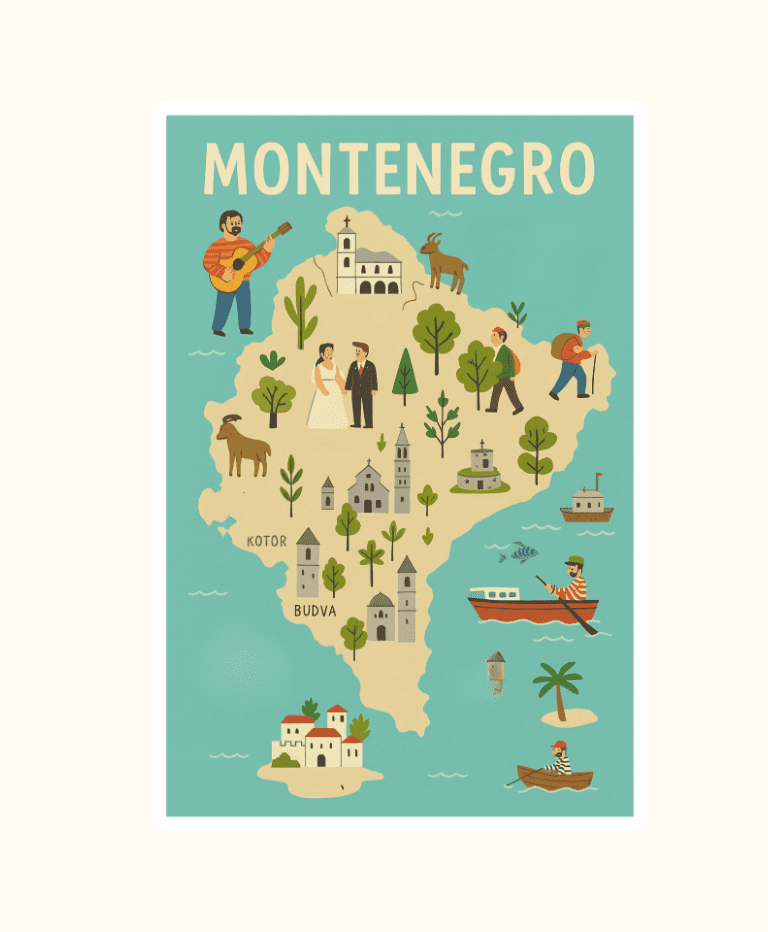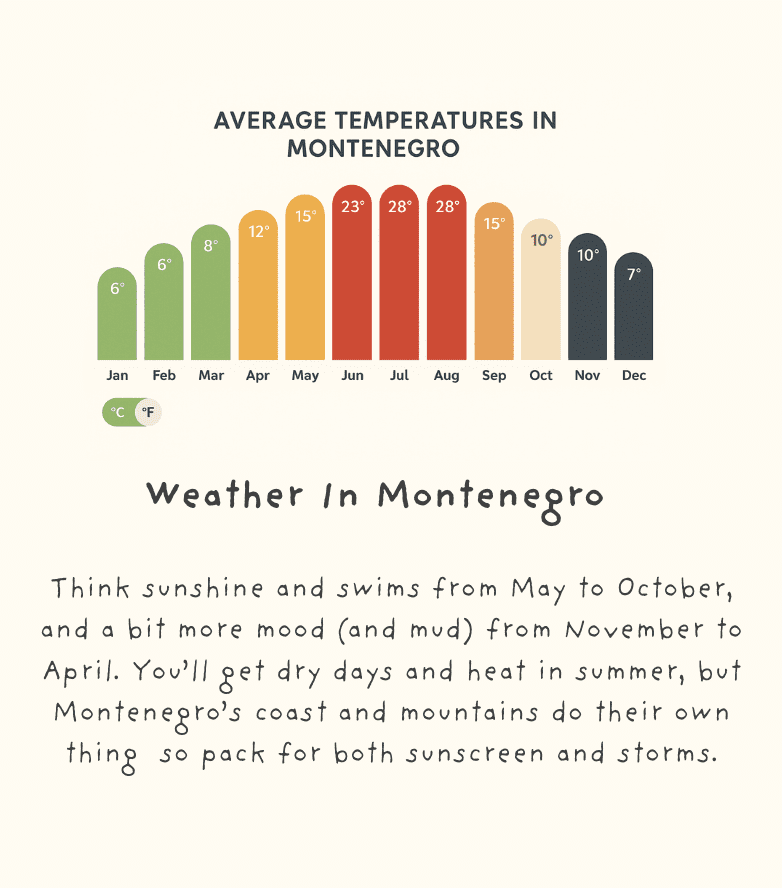BUDVA
EURO
€550 – €1700
Mediterranean with
Short colder winters


Yes! With its mix of beaches, mountains, and historic towns, Montenegro offers a lot for family travellers especially if you enjoy nature and slower-paced exploring.
Most families find 7–10 days is a sweet spot. It gives you time to explore Kotor Bay, dip into the Adriatic, and road trip through the mountains without rushing.
Old towns like Kotor and Budva have cobblestones and steps, which can be tricky — but promenades, beaches, and many parks are stroller-friendly. A baby carrier helps for uneven paths.
May to September offers sunshine, swimmable seas, and family-friendly festivals. July–August is peak season (and busier), so June or early September can be ideal.
Montenegro is a country of seasons, and they each bring something different depending on what kind of trip you’re after.
Summer (June to August)
Is peak season. Coastal towns like Kotor, Budva, and Herceg Novi come alive with festivals, boat trips, and beach days. Expect dry weather, temps in the high 20s°C, and a buzzy but sometimes crowded atmosphere. Book early.
Shoulder seasons (May, September, early October)
Are arguably the best time to visit. You’ll still get warm days (low-mid 20s°C), but without the crowds or inflated prices. Hiking trails in Durmitor or the Bay of Kotor are quieter, and accommodation deals are easier to find.
Winter (November to March)
Is off-season on the coast but opens up skiing in the north Kolasin and Zabljak are Montenegro’s small but scenic ski areas. Inland, it gets cold (snow and sub-zero temps common), but this is the time for mountain lovers and budget-conscious travellers.
Tip: Rain is more common from November to April, especially along the coast. Pack layers and don’t underestimate Montenegro’s climate diversity.
Montenegro’s coastline might be short, but it packs a punch. From beach bars to hidden coves, here are some of the best spots to swim, splash, and unwind.
Sveti Stefan – Picture-perfect with pink pebbles and a postcard island view. It’s not cheap, but it’s iconic.
Tara River – Inland wild swimming spot. Think crystal water, dramatic cliffs, and safe shallows for families. Our pick? A local secret near the Manastir Svetog Arhangela Mihaila. (Yes, that one with 4 wrong turns and a pack of Haribo…)
Jaz Beach – Just outside Budva, this long beach is family-friendly but still has enough space to feel wild.
Lake Skadar – Great for freshwater swims, kayaking, and spotting pelicans.
Tip: Swim shoes help on the pebbly beaches, and the Adriatic can stay cool early in the season.
Montenegro’s culture is a blend of Balkan traditions, Mediterranean flavours, and mountain hospitality.
Food – Think hearty stews in the mountains (like kacamak and lamb cooked under a bell) and seafood on the coast (grilled squid, black risotto, and buzara). Don’t skip the rakija, it’s strong, homemade, and often free.
Culture – Orthodox and Catholic traditions sit alongside Venetian and Ottoman influences. Expect stone churches, lively town squares, and festivals that celebrate everything from music to prosciutto.
Family-Friendly Vibes – Montenegrins love kids. You’ll get warm welcomes at restaurants, and there’s no pressure to hush the chaos it’s embraced.
Tip: Try a village homestay inland for a taste of slow travel and real local connection.
Montenegro remains one of Europe’s most rewarding yet underrated destinations.
Its small size makes it easy to explore, yet it packs in an incredible range of experiences. You can wake up in a historic seaside town, spend midday hiking above a glacial lake, and end the day swimming in a river under the mountains.
Montenegro appeals to a wide range of travellers:
Families looking for short distances and varied activities
Couples seeking romantic scenery and off-grid stays
Adventure-seekers chasing canyoning, rafting, or backcountry hikes
Budget-conscious travellers avoiding the high prices of neighbouring Croatia and Italy
Destinations like Kotor, Perast, and Ulcinj offer coastal charm, while Durmitor and Biogradska Gora provide a more rugged, natural experience.
Montenegro is still evolving as a tourism destination. That means fewer crowds (outside summer), authentic experiences, and lots of opportunity to find your own slice of calm.
Montenegro is a relatively easy country to navigate, especially for travellers who like to explore independently. Still, a few tips can help smooth the journey.
Transport: Public buses run frequently between major towns, but routes into the mountains can be less regular. Renting a car gives flexibility and access to the country’s best off-grid locations — just be prepared for winding roads.
Safety: The country is generally very safe. Petty theft is rare but keep your belongings secure in crowded areas, especially in summer hotspots. Driving requires focus — mountain roads can be narrow and not always well signposted.
Health: Tap water is safe to drink. Healthcare is basic in some rural areas but reliable in the main cities. Bring any necessary medication with you, as pharmacy stock can vary.
Connectivity: Most towns and accommodations offer decent Wi-Fi. Local SIM cards are cheap and a good backup, especially for navigation.
Packing tips: Bring layers, even in summer. The coast can be hot, but evenings inland and in the mountains cool down quickly. Hiking shoes, swimwear, and a light rain jacket cover most scenarios.
Montenegro is a country of seasons, and they each bring something different depending on what kind of trip you’re after.
Summer (June to August)
Is peak season. Coastal towns like Kotor, Budva, and Herceg Novi come alive with festivals, boat trips, and beach days. Expect dry weather, temps in the high 20s°C, and a buzzy but sometimes crowded atmosphere. Book early.
Shoulder seasons (May, September, early October)
Are arguably the best time to visit. You’ll still get warm days (low-mid 20s°C), but without the crowds or inflated prices. Hiking trails in Durmitor or the Bay of Kotor are quieter, and accommodation deals are easier to find.
Winter (November to March)
Is off-season on the coast but opens up skiing in the north Kolasin and Zabljak are Montenegro’s small but scenic ski areas. Inland, it gets cold (snow and sub-zero temps common), but this is the time for mountain lovers and budget-conscious travellers.
Tip: Rain is more common from November to April, especially along the coast. Pack layers and don’t underestimate Montenegro’s climate diversity.
Montenegro’s coastline might be short, but it packs a punch. From beach bars to hidden coves, here are some of the best spots to swim, splash, and unwind.
Sveti Stefan – Picture-perfect with pink pebbles and a postcard island view. It’s not cheap, but it’s iconic.
Tara River – Inland wild swimming spot. Think crystal water, dramatic cliffs, and safe shallows for families. Our pick? A local secret near the Manastir Svetog Arhangela Mihaila. (Yes, that one with 4 wrong turns and a pack of Haribo…)
Jaz Beach – Just outside Budva, this long beach is family-friendly but still has enough space to feel wild.
Lake Skadar – Great for freshwater swims, kayaking, and spotting pelicans.
Tip: Swim shoes help on the pebbly beaches, and the Adriatic can stay cool early in the season.
Montenegro’s culture is a blend of Balkan traditions, Mediterranean flavours, and mountain hospitality.
Food – Think hearty stews in the mountains (like kacamak and lamb cooked under a bell) and seafood on the coast (grilled squid, black risotto, and buzara). Don’t skip the rakija, it’s strong, homemade, and often free.
Culture – Orthodox and Catholic traditions sit alongside Venetian and Ottoman influences. Expect stone churches, lively town squares, and festivals that celebrate everything from music to prosciutto.
Family-Friendly Vibes – Montenegrins love kids. You’ll get warm welcomes at restaurants, and there’s no pressure to hush the chaos it’s embraced.
Tip: Try a village homestay inland for a taste of slow travel and real local connection.
Montenegro remains one of Europe’s most rewarding yet underrated destinations.
Its small size makes it easy to explore, yet it packs in an incredible range of experiences. You can wake up in a historic seaside town, spend midday hiking above a glacial lake, and end the day swimming in a river under the mountains.
Montenegro appeals to a wide range of travellers:
Families looking for short distances and varied activities
Couples seeking romantic scenery and off-grid stays
Adventure-seekers chasing canyoning, rafting, or backcountry hikes
Budget-conscious travellers avoiding the high prices of neighbouring Croatia and Italy
Destinations like Kotor, Perast, and Ulcinj offer coastal charm, while Durmitor and Biogradska Gora provide a more rugged, natural experience.
Montenegro is still evolving as a tourism destination. That means fewer crowds (outside summer), authentic experiences, and lots of opportunity to find your own slice of calm.
Montenegro is a relatively easy country to navigate, especially for travellers who like to explore independently. Still, a few tips can help smooth the journey.
Transport: Public buses run frequently between major towns, but routes into the mountains can be less regular. Renting a car gives flexibility and access to the country’s best off-grid locations — just be prepared for winding roads.
Safety: The country is generally very safe. Petty theft is rare but keep your belongings secure in crowded areas, especially in summer hotspots. Driving requires focus — mountain roads can be narrow and not always well signposted.
Health: Tap water is safe to drink. Healthcare is basic in some rural areas but reliable in the main cities. Bring any necessary medication with you, as pharmacy stock can vary.
Connectivity: Most towns and accommodations offer decent Wi-Fi. Local SIM cards are cheap and a good backup, especially for navigation.
Packing tips: Bring layers, even in summer. The coast can be hot, but evenings inland and in the mountains cool down quickly. Hiking shoes, swimwear, and a light rain jacket cover most scenarios.
We’re Sean, Tania, Atticus (8), and Aurelia (6) a not-so-ordinary family trading routines for backpacks and school runs for border crossings. In 2025, we set off on a year(ish) of slow travel through South and Central America.
No trust funds, no grand plan, just big dreams, small backpacks, and a lot of figuring it out as we go. From desert dunes to jungle hikes (and the occasional Netflix night in between), we’re learning how to make adventure our new normal.
Come along as we share honest family travel guides, kid-proof tips, and stories from the road, the good, the chaotic, and everything in between.
© 2025 Travel Venture Four. Inspiring family adventures across South America.